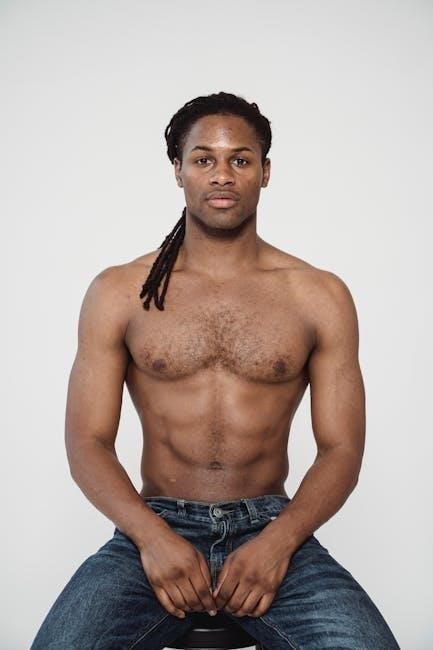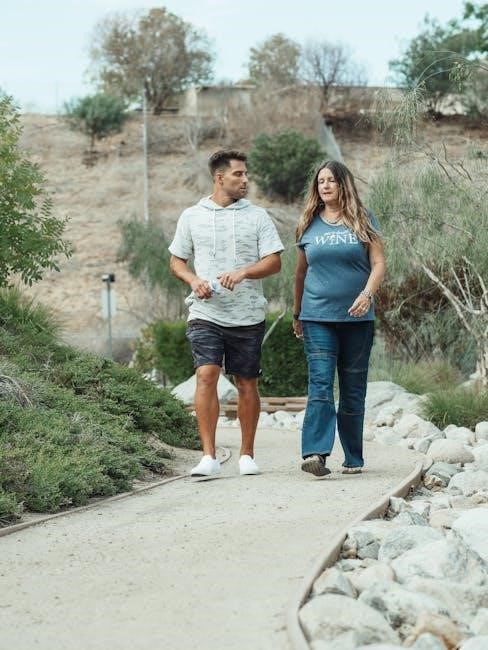Discover how to find the perfect fit for your body type, with expert tips on leg shape, rise, inseam, and fabric. This guide offers practical advice for a comfortable, stylish choice.
The Importance of Proper Fit in Men’s Jeans
A proper fit in men’s jeans is essential for both style and comfort. Ill-fitting jeans can lead to discomfort and an unflattering appearance. Jeans that are too tight may restrict movement, while those that are too loose can look sloppy. The ideal fit should feel snug but not restrictive, with the pant line following the natural shape of your body. Properly fitted jeans enhance your posture and confidence, making them a wardrobe staple. When trying on jeans, use the Pull-On Test to ensure comfort and avoid sagging. Additionally, the Sit and Squat Tests can help determine practicality. The right fit balances style and functionality, ensuring you look and feel your best. Accurate sizing and understanding your body type are crucial for achieving this perfect balance.
Key Elements to Consider for a Perfect Fit
When searching for the perfect fit in men’s jeans, several key elements must be considered. First, inseam measurement is crucial, as it determines the length of the jeans and how they sit on your shoes. Next, the rise—whether low, mid, or high—plays a significant role in comfort and style. The leg shape, such as skinny, slim, straight, or relaxed, should complement your body type. Fabric choice, including cotton, stretch, or premium materials, affects both durability and comfort. Proper sizing ensures the jeans are neither too tight nor too loose, while the Pull-On Test can help gauge initial comfort. Additionally, the Sit and Squat Tests provide practical insights into how the jeans will perform in real-life scenarios. Balancing these elements ensures a fit that is both stylish and functional, tailored to your unique needs and preferences.
The Difference Between Style and Comfort
Style and comfort are two critical yet distinct factors when choosing men’s jeans; Style often revolves around aesthetic preferences, such as leg shape, rise, and fabric texture, which can enhance your appearance and align with current trends. Comfort, on the other hand, focuses on how the jeans feel throughout the day, influenced by factors like stretchiness, inseam length, and waistband design. While style may prioritize a sleek, modern look, comfort ensures the jeans remain wearable for extended periods without restriction or discomfort. Achieving a balance between the two is key, as overly stylish jeans may sacrifice practicality, while prioritizing comfort alone might result in a less fashionable choice. The ideal pair should blend both elements, offering a flattering fit that feels as good as it looks. This balance ensures you can enjoy both confidence and ease in your daily life.

Understanding Your Body Type
Identifying your body type—ectomorph, mesomorph, or endomorph—is crucial for selecting jeans that flatter your frame and ensure a perfect fit, balancing style and comfort effortlessly.
Ectomorph: Slim and Lean Body Type
Ectomorphs have a naturally slim, lean build with smaller bone structures. For this body type, jeans should create a balanced, proportional look without appearing overly tight or baggy. Slim-fit or skinny jeans work well, as they hug the legs without adding bulk. Mid-rise or low-rise options can elongate the torso and create a flattering silhouette. Stretch denim is highly recommended for ectomorphs, as it provides comfort and flexibility while maintaining a sleek appearance. Avoid overly loose fits, as they can make the frame appear even slimmer. Instead, opt for styles that offer Structure through the thigh and taper slightly at the ankle for a polished look. Pairing with tailored tops or jackets can further enhance the overall aesthetic, ensuring a harmonious balance between style and comfort.
Mesomorph: Athletic Build
Mesomorphs have an athletic build, characterized by muscular legs and a well-defined torso. Jeans for this body type should complement the natural shape while providing comfort and flexibility. Straight-fit or slim-fit jeans are ideal, as they hug the thighs without restricting movement. Mid-rise or high-rise options can provide additional support and coverage, which is beneficial for those with stronger legs. Stretch denim is highly recommended, as it offers flexibility for active lifestyles while maintaining a sleek appearance. Avoid overly tight fits that may constrict muscles, and steer clear of overly loose styles that can overwhelm the frame. Pairing with fitted tops or jackets can enhance the overall look, creating a balanced silhouette that highlights the athletic build. Ensuring the inseam is proportionate to the body is key, as it prevents the jeans from being too long or too short.
Endomorph: Larger Body Type
Men with an endomorph body type tend to carry more weight, particularly around the midsection and thighs. For this build, comfort and a balanced silhouette are key. Relaxed-fit or loose-fit jeans are ideal, as they provide ample room in the seat and thigh areas while avoiding a restrictive feel. High-rise styles can offer additional support and coverage, helping to create a more streamlined look. Fabric choice is crucial; opt for stretch denim or premium fabrics with give, as they accommodate larger frames without sacrificing style. Avoid skinny or slim-fit jeans, as they may feel too tight and accentuate areas disproportionately. Pairing with tailored tops can help balance the overall appearance. Ensuring the inseam is appropriate for your height prevents the jeans from pooling at the ankles or feeling overly short. This combination ensures both comfort and a polished look for larger body types.
Rise Options in Men’s Jeans
Rise options significantly impact the fit and style of jeans. High-rise offers timeless elegance, mid-rise provides balance, while low-rise emphasizes modern trends. Choose based on comfort, body type, and personal style.
Low-Rise Jeans: Pros and Cons
Low-rise jeans are a modern and trendy option, sitting below the natural waistline. They offer a sleek, contemporary look and are ideal for slimmer body types. However, they may lack support for larger builds. Pros include a fashionable aesthetic and versatility with casual outfits. Cons involve potential discomfort due to the lower fit and restricted mobility. Avoid sagging under the butt for a flattering appearance. Pair with longer tops for balance. While stylish, they may not suit everyone, emphasizing the importance of personal comfort and body type alignment.
- Pros: Modern style, versatility, slimming effect.
- Cons: Limited support, potential discomfort, restricted mobility.
Mid-Rise Jeans: A Balanced Choice
Mid-rise jeans strike a perfect balance between style and comfort, sitting just below the natural waistline. They are versatile and suitable for most body types, offering a classic look that never goes out of fashion. The mid-rise design provides better support and coverage compared to low-rise styles, making them ideal for both casual and semi-formal settings. They are particularly flattering on ectomorphs and mesomorphs, as they create a proportional silhouette. However, they may not be the best choice for endomorphs, as they can feel restrictive around the midsection. Pair mid-rise jeans with fitted tops for a streamlined look or loose-fitting shirts for a relaxed vibe. Their timeless appeal makes them a staple in any wardrobe.
- Pros: Versatile, supportive, classic style.
- Cons: May feel restrictive for larger body types.
High-Rise Jeans: Timeless Elegance
High-rise jeans are a classic choice that offers timeless elegance and exceptional comfort. Sitting higher on the waist, they provide excellent support and coverage, making them ideal for a variety of body types. These jeans are particularly flattering for endomorphs, as they create a balanced silhouette and streamline the midsection. They also suit ectomorphs and mesomorphs, offering a polished look that works well for both casual and formal occasions. High-rise styles often feature a more traditional fit and are versatile enough to pair with dressed-up shirts or casual tops. They are a great option for those seeking a retro or sophisticated aesthetic. With their enduring appeal, high-rise jeans remain a wardrobe staple for men who value both style and comfort.
- Pros: Timeless style, excellent support, versatile pairing options.
- Cons: May feel less trendy for some fashion preferences.

Leg Shapes in Men’s Jeans
Leg shapes define the fit and style of jeans, ranging from skinny to relaxed. Each style suits different body types and fashion preferences, ensuring comfort and a tailored look.
Skinny Fit: Tight Through the Leg
The skinny fit jeans are designed to be tight from thigh to ankle, offering a contemporary look. They are ideal for slim body types and pair well with tailored tops for a chic style. Skinny jeans provide a sleek silhouette and are perfect for fashion-forward individuals. They are often made from stretch fabrics for comfort, ensuring they don’t feel restrictive. However, they may not suit everyone, especially those with larger legs. Proper sizing is key to avoid discomfort and maintain the desired aesthetic. The skinny fit is a popular choice among trendsetters and works well in both casual and semi-formal settings. Balancing proportions is essential when wearing skinny jeans. Pairing them with loose-fit tops can create a balanced look, while tight tops enhance the slimming effect. The skinny fit is a versatile option for those who embrace modern fashion trends and prefer a snug, streamlined appearance.
Slim Fit: Modern and Streamlined
The slim fit offers a modern, streamlined look by hugging the legs without being overly tight. It strikes a balance between skinny and straight fits, making it versatile for various body types, especially ectomorphs and mesomorphs. The slim fit is designed to taper slightly from the knee down, creating a sleek, fashionable silhouette. Unlike skinny jeans, it provides a bit more room, ensuring comfort while maintaining a stylish appearance. This fit is ideal for those who want to look sharp without sacrificing mobility. Pairing slim-fit jeans with a fitted top enhances the streamlined effect, while looser tops can add a casual touch. The slim fit is a popular choice for its adaptability to both casual and semi-formal settings. When selecting slim-fit jeans, focus on a snug but comfortable fit around the thigh, as this ensures the best look and feel. Proper sizing is key to avoiding an overly tight or loose appearance. The slim fit is a timeless option for men seeking a modern, polished style.
Straight Fit: Classic and Comfortable
The straight fit is a timeless choice offering unmatched comfort and versatility. It features a consistent width from thigh to ankle, creating a clean, classic look. Unlike slim or skinny fits, straight-leg jeans do not taper, making them ideal for all body types, especially endomorphs or those seeking a relaxed feel. The straight fit is perfect for everyday wear, pairing well with both casual and dressy outfits. It allows for ease of movement and is particularly flattering on taller men, as it elongates the legs. When choosing straight-fit jeans, ensure they are not too loose, as this can create a boxy appearance. The straight fit is a reliable option for men who value comfort without compromising on style, making it a wardrobe staple for any occasion. Its classic design ensures it remains fashionable across seasons and trends.
Relaxed Fit: Roomy and Casual
The relaxed fit offers a roomy, casual option designed for ultimate comfort. It features a loose design through the seat, thigh, and leg, making it ideal for men who prioritize ease of movement and a laid-back style. This fit is perfect for casual settings and works well for endomorph body types or those seeking a more comfortable option. The relaxed fit avoids the restrictive feel of slimmer styles, allowing for a natural range of motion. However, it’s important to balance the looseness to avoid a overly baggy appearance. Pairing relaxed-fit jeans with fitted tops can create a balanced look. The relaxed fit is also versatile, suitable for both everyday wear and outdoor activities. Its roomy design makes it a great choice for layering during colder months. This fit is a go-to for men who value comfort and a casual aesthetic without sacrificing style. Its loose silhouette ensures a relaxed yet polished look.

Fabric Types and Their Impact on Fit
Fabric choice significantly affects comfort and fit. Cotton offers durability, while stretch fabrics provide flexibility. Premium materials enhance both style and comfort, ensuring a tailored feel for every body type.
Cotton Jeans: Durability and Tradition
Cotton jeans are a timeless choice, offering unmatched durability and a classic feel. Pure cotton fabrics provide a sturdy, traditional fit that resists excessive stretching. Jeans made from 97% cotton will ease up with wear, feeling slightly tight initially but becoming more comfortable over time. This natural fiber ensures a breathable, long-lasting garment. For the best fit, opt for a snug size, as cotton jeans will loosen slightly with use. Their versatility makes them suitable for various body types, blending style with practicality. Cotton remains the go-to choice for those seeking reliability and a traditional denim experience.
Stretch Jeans: Flexibility and Comfort
Stretch jeans offer unparalleled flexibility and comfort, making them ideal for active lifestyles. Blending cotton with elastane or spandex, these jeans provide a full range of motion while maintaining a sleek appearance. Unlike pure cotton jeans, stretch denim adapts to your body, eliminating stiffness and discomfort. This hybrid fabric is perfect for men who value both style and practicality, ensuring a snug yet flexible fit. For the best experience, opt for a pair with a moderate stretch percentage, as excessive elasticity can compromise durability. Stretch jeans are particularly suited for athletic or mesomorph body types, offering support without restriction. They also ease up slightly with wear, making them a versatile choice for everyday wear.
Premium and Alternative Fabrics
Premium and alternative fabrics elevate your jeans beyond the basics. Luxurious options like Tencel or bamboo blends offer softness and breathability, while innovative materials such as recycled denim promote sustainability. These fabrics cater to specific needs: Tencel provides temperature regulation, bamboo adds natural antibacterial properties, and recycled denim supports eco-conscious fashion. For a refined look, consider selvedge denim, known for its tight weave and durability. These premium options often feature advanced weaving techniques, ensuring a superior fit and feel. Whether you prioritize comfort, sustainability, or style, premium and alternative fabrics offer a tailored experience, enhancing both the aesthetic and functionality of your jeans. They are ideal for those seeking a unique, high-quality addition to their wardrobe.
Inseam and Sizing Considerations
Inseam and sizing are crucial for the perfect fit. Measure accurately to ensure jeans match your height and style preferences, avoiding excess fabric or tight constraints for optimal comfort.
Understanding Inseam Measurements
Inseam measurements are key to ensuring your jeans fit perfectly. The inseam refers to the length of the pant leg from the crotch to the bottom of the hem. Proper inseam ensures the jeans sit well on your shoes without dragging or being too short. When trying jeans, pay attention to how the inseam aligns with your body. For shorter individuals, a shorter inseam prevents excess fabric bunching around the ankles, while taller men benefit from longer inseams to avoid a too-short appearance. Accurate inseam measurements are essential for both style and comfort, ensuring the jeans move naturally with your legs. Always check the inseam length when purchasing, as it varies between styles and brands. This attention to detail will help you achieve a polished, well-fitted look.
How Inseam Relates to Your Height
Your height plays a significant role in determining the ideal inseam length for your jeans. For shorter men, a shorter inseam ensures the jeans do not bunch up around the ankles, creating a more streamlined appearance. Taller individuals, on the other hand, benefit from longer inseams to prevent the pants from appearing too short. Generally, inseam lengths are categorized to suit different height ranges, ensuring a balanced fit. For example, men under 5’6″ often prefer inseams between 26-28 inches, while those over 6′ may opt for 32 inches or more. By aligning inseam with height, you achieve a proportional fit that enhances both comfort and style. This consideration is vital for creating a polished, well-tailored look that complements your physique. Always check inseam measurements relative to your height for the best results.
The Importance of Accurate Sizing
Accurate sizing is crucial for ensuring both comfort and style in men’s jeans. Ill-fitting jeans can disrupt your entire look, making you appear either overly baggy or uncomfortably tight. Proper sizing ensures the jeans sit well on your waist, hips, and legs, creating a balanced and flattering silhouette. A well-fitted pair enhances your confidence and makes styling easier. To achieve this, use sizing charts as a starting point, but remember that sizes can vary between brands. Consider the “Pull 3 Trick” when shopping: try your size, one up, and one down to find the best fit. Additionally, factors like fabric stretch and intended use (casual vs. formal) influence sizing choices. Taking the time to ensure accurate sizing guarantees a pair of jeans that feels great and looks even better, making it a worthwhile investment for your wardrobe.

Trying Jeans On: What to Look For
Ensure comfort by performing the Pull-On Test and Sit and Squat Tests. Jeans should feel snug but not restrictive, with a natural fit around the waist and thighs.
The Pull-On Test: Ensuring Comfort
The Pull-On Test is a simple yet effective way to gauge comfort and fit when trying on jeans. To perform the test, slip on the jeans and ensure they feel snug but not restrictive. Pay attention to how they sit on your waist and hips—there should be no excessive tightness or sagging. If the jeans feel too tight, it may indicate a smaller size is needed, while sagging suggests a larger size might be more appropriate. This test helps determine if the jeans will remain comfortable throughout the day, especially during movement. A proper fit should allow for a full range of motion without constriction. By prioritizing comfort during this initial test, you can ensure a more enjoyable wearing experience. Additionally, consider the fabric type, as stretch denim may offer more flexibility than pure cotton, enhancing overall comfort.
The Sit and Squat Tests: Practical Fit Checks
After the Pull-On Test, the Sit and Squat Tests provide further insight into how the jeans perform in real-life scenarios. Begin by sitting down in the jeans, paying attention to how the fabric moves with your body. The jeans should not feel restrictive or pinch when you sit, as this could signal a poor fit for everyday activities. Next, perform a squat to assess flexibility and comfort. If the jeans ride up excessively or feel tight around the thighs, they may not be suitable for active use. These tests ensure the jeans offer both comfort and mobility, crucial for long-term satisfaction. By combining these practical checks, you can confidently determine if the jeans are right for your lifestyle and needs.
